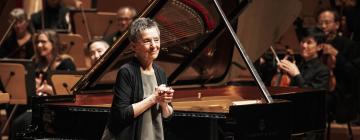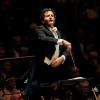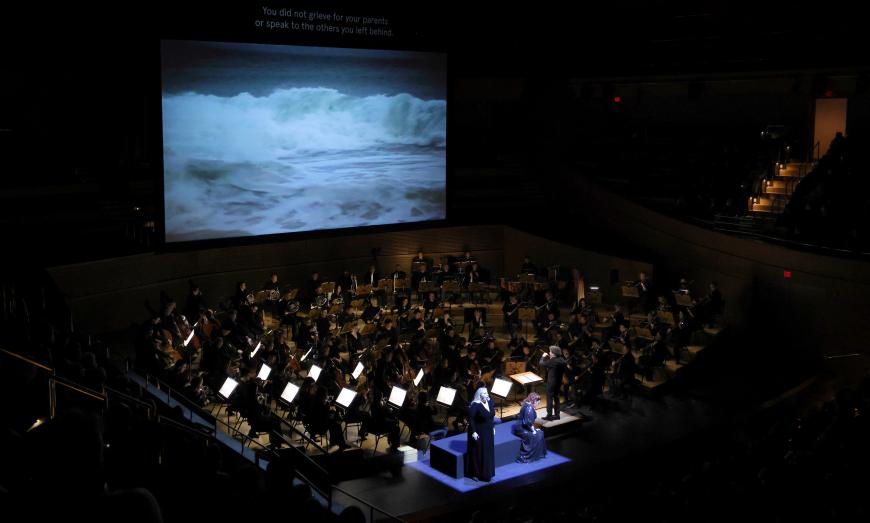
In December 2004, the Los Angeles Philharmonic’s Tristan Project jolted the orchestral world with its pathbreaking multimedia production of Richard Wagner’s Tristan und Isolde — a work that itself was a jolt to the musical world of 1865.
A film by visual artist Bill Viola was shown concurrently with the performance, creating a parallel Tristan universe that was supposed to venture beyond the plot into the subconscious philosophies that drove Wagner to write it. The surround-sound design of Walt Disney Concert Hall was utilized by stage director Peter Sellars to place the singers and choristers in positions around the hall. It looked like something new, futuristic, and mysterious, a prophecy of higher-tech concert-hall productions to come.
And yet, who were the real heroes of this project, the ingredients that ultimately did the most to make this Tristan a more powerful experience than most productions from conventional opera companies? It was the LA Phil itself, seated in its accustomed open position in Disney Hall, freed from the acoustical confines of an opera pit and playing its collective heart out, armed with nothing but “low-tech” acoustical instruments descended from Wagner’s time. This was true in 2004, it was equally true in 2007 when the production was repeated, and it was triumphantly true last weekend (Dec. 9–11) when the Tristan Project came back home to where it was launched 18 years ago.
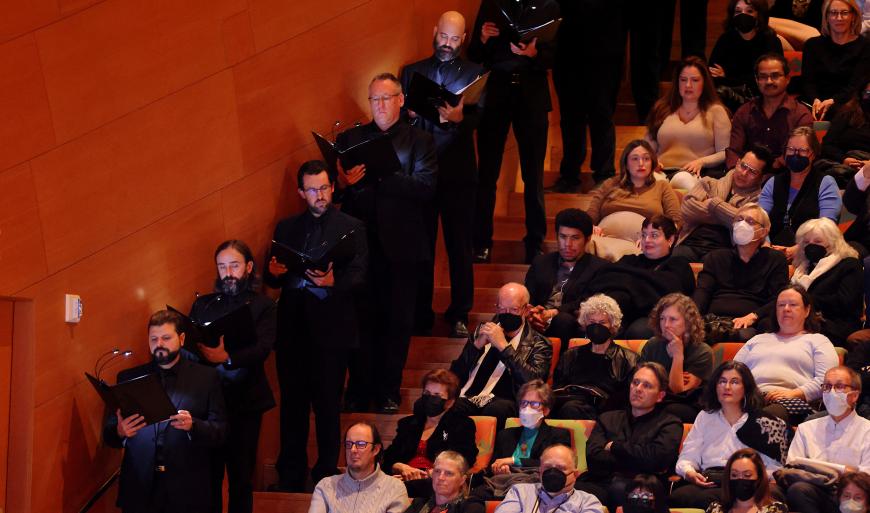
Gustavo Dudamel essentially inherited the project from its original conductor, Esa-Pekka Salonen, who was on the podium in 2004 and 2007 and was supposed to have returned in October 2020 (when this revival was originally scheduled, only to be postponed by the COVID shutdown). Dudamel also revived the original 2004 idea of dividing the performance among three concerts, one act per day. (Salonen did the whole opera in one evening in 2007 and was going to do so again in 2020).
This subdivision of Wagner has the advantage of lessening the burden on musicians and listeners alike. Singers can give all they’ve got with less concern for fatigue, and audiences can concentrate more fully on those long stretches of swirling, harmonically unresolving, hyperemotional, undeniably great music. The disadvantages are mainly non-musical — having to pay for three tickets in order to hear a single opera (although the Phil offered Wagnerites a bit of a price break with a three-concerts-for-the-price-of-two online deal) and having to fight your way through three L.A. traffic jams instead of just one. In any case, three consecutive offerings of Wagner made the event feel like a festival, kind of like a mini-Ring Cycle in which you can go home and contemplate what you’ve heard before venturing out again. There’s a lot to be said for that approach, as opposed to one long evening.
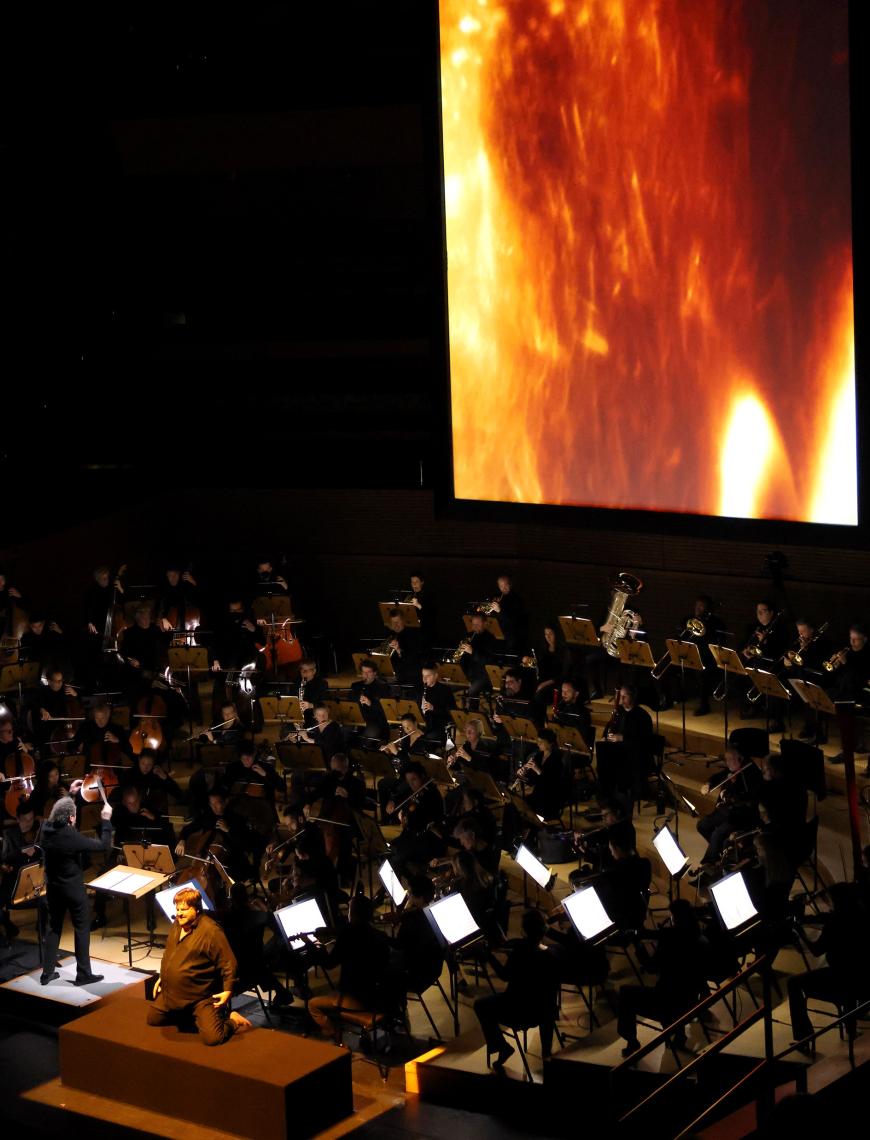
The Viola film was shown on the same screen as before, a huge, slightly curved rectangle that for Act 3 was flipped 90 degrees on its end to form a tower. During the first act, the film depicts a purification ritual of sorts in which two stand-ins for Tristan and Isolde perform a slow-motion striptease in separate rooms, after which they are doused with water. When they end up underwater, here and elsewhere in the film, this is supposed to represent a free-floating state of lovers’ nirvana removed from reality.
Long stretches of coarse-grained black-and-white images form a stark contrast with stunning time-lapse progressions of fire or water and Tristan striding into the flames as the Act 2 love duet begins — the signature image of the whole film. In Act 3, fire and water combine to form abstract, vibrating waves. Sometimes, you can catch Viola reacting directly to the text; when the supertitles announce, “Fleeting brilliance of flickering lights,” he shows the lighting of a sea of prayer candles as if in a Catholic church. With the use of film, Viola can offer an answer to an age-old problem of how to stage Isolde’s “Transfiguration,” the film Tristan gradually levitating upward in the watery mist as the stage Isolde sings, love finding its fulfillment in death.
Even in the most elaborate of opera-house productions of Tristan, there isn’t much action to stage, so it wasn’t surprising that Sellars again confined himself mostly to placing the singers in various heights of the side garden and terrace seating areas, as well as in front of the Phil. As I recall, the 2004 performances found most of the cast reading from scores; this time everyone had their parts memorized, which allowed for some limited acting gestures.
The Finnish soprano Miina-Liisa Värelä got through Act 1 OK, offering a somewhat matronly Isolde early on with a bit of harshness in the upper register, but it was announced prior to the performance of Act 2 that she was feeling “under the weather.” Nevertheless, she soldiered on through the act, carefully conserving her resources at a low volume in the opening scene and treading sweetly through the long love duet. In Act 3, she bloomed as if a real-life Brangäne had slipped her a magic elixir overnight, culminating in a lovely “Transfiguration” in full voice.
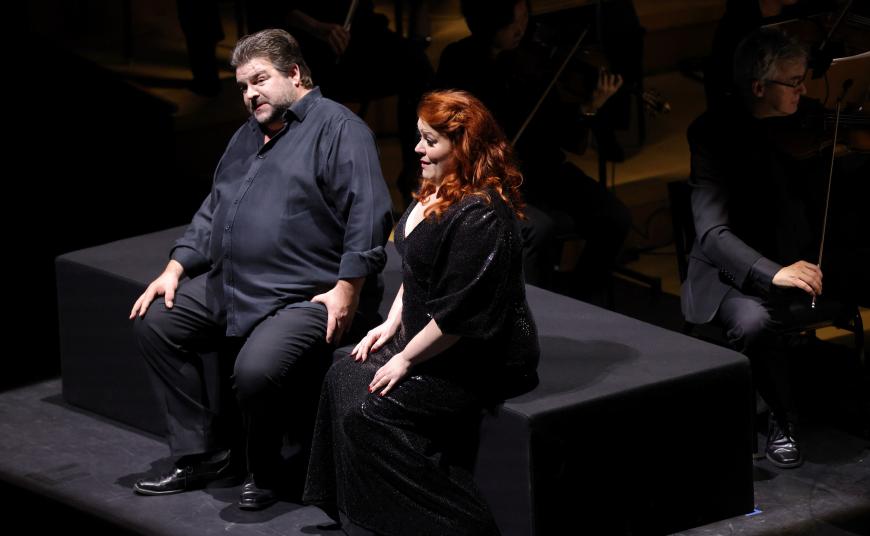
Michael Weinius sang a satisfying Tristan in the heldentenor tradition, leaning more toward Vickers than Windgassen in timbre, and mezzo-soprano Okka von der Damerau was a strong Brangäne. Bass-baritone Ryan Speedo Green was an outstanding Kurwenal, with plenty of amplitude, passion, and deep bass resonance, while veteran bass-baritone Eric Owens’s King Marke sounded shaky yet justifiably so within the parameters of his aging character.
With all that said, the orchestral score, played brilliantly by a clearly charged-up LA Phil, with Dudamel driving the musicians on in a far more physically active manner than typical in recent years, remained the main attraction. When he turned on the juice, he conjured brush fires of sudden passion, sometimes overwhelming even the ample voices of the singers. His tempos overall came in on the moderately fast side, falling within Salonen’s tempo range in 2004 and 2007, yet you could feel the heat of the score more intensely, all of the climaxes astutely timed.
This was Dudamel’s first Tristan — his second will be a full production with the Paris Opera in January 2023 — and he has a consummately tight grip on it already. Even if you buy the visual premise of Viola’s film, you could close your eyes in Disney Hall and still get a full charge out of Tristan’s danger and power.
The Tristan Project repeats Thursday through Saturday (Dec. 15–17).
